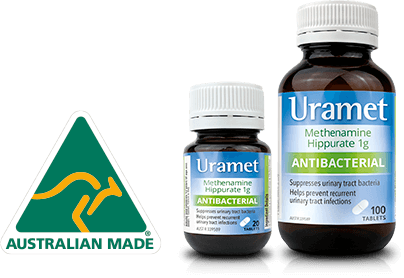
Frequently Asked Questions
We’ve pulled together some commonly
asked questions to give you more
information about URAMET and UTIs.

About urinary tract infections (UTIs)
1. What is the ‘urinary tract’?
The urinary tract (also known as the urinary system) consists of the kidneys, bladder, ureters and urethra. It is responsible for removing extra fluids and waste from the body in the form of urine. The urinary system is designed so that urine flows one way and is normally prevented from flowing back up into the kidneys.
2. What causes urinary tract infections (UTIs)?
UTIs occur when micro-organisms (typically bacteria) enter and travel up the urinary tract and multiply, causing an infection. The infection can affect any part of the urinary tract, most commonly the bladder.
3. Why are UTIs more common in women than men?
For the urinary tract to become infected, bacteria need be able to reach and then travel through the urethra. Compared to men, the urethra in women is short (only about 4 cm long), which makes it easier for bacteria to travel along it and up into the bladder causing an infection.
For some women UTIs are also linked to the normal changing hormone levels that occur throughout their lives.
4. How do I know if I have a UTI?
Some of the symptoms of a UTI include;
- A burning pain or sensation when urinating
- Wanting to urinate more frequently than normal
- Feeling like your bladder is still full after passing urine
- Pain in your lower abdomen above the pubic bone
- Cloudy, bloody or smelly urine.
However, while these are symptoms of a UTI, the best way to be sure is to seek a diagnosis from a healthcare professional.
5. What should I do if I think I have a UTI?
If you think you have a UTI, it is important that you talk first to a healthcare professional.
6. How are urinary tract infections diagnosed?
In order to diagnose a UTI, your doctor will ask about your symptoms. They may conduct a physical examination and take a urine sample to see which bacteria are present.
If you think you may have a UTI, it is important to consult a doctor. The doctor will advise on the most appropriate treatment.
7. Is there anything else I can do if I have a UTI?
If you think you may have a UTI, it is important to consult a healthcare professional.
Drinking lots of water can help flush bacteria out of your urinary system, while taking a urinary alkaliniser (such as URAL Effervescent Powder) can relieve the burning pain of UTIs.
Uramet can only be used to help prevent recurrent UTIs once the initial infection has been treated — it should not be taken when you are also taking a urinary alkalising agent (such as URAL Effervescent Powder), as this may affect how well Uramet works.
Recurrent Urinary Tract Infections
8. What is a recurrent urinary tract infection?
A recurrent UTI is characterised by the occurrence of another infection following the complete resolution of a previous UTI. Guidelines for UTIs define recurrent UTIs as when you have two or more urinary tract infections diagnosed by your doctor in the past 6 months or three or more in a 12-month period.
9. Why do I keep getting urinary tract infections?
There are certain factors that make some women more susceptible to getting repeated (recurrent) UTIs, these include:
- History of childhood UTIs
- A family history of recurrent UTIs
- Sexual activity and a new sexual partner
- Using spermicides or a diaphragm as a means of contraception
- Menopause
- Suffering from constipation.
10. What can I do to help prevent urinary tract infections from coming back?
- Drink plenty of water (and other fluids) to help flush bacteria out of your urinary system
- Urinate after sexual intercourse
- Treat any vaginal infections, like thrush, quickly
- Avoid using spermicide containing contraceptive products
- Don’t delay going to the toilet. Don’t hold on. Go as soon as you feel the urge to urinate
- Wipe yourself from front to back (urethra to anus) after going to the toilet
- Avoid Constipation.
About Uramet
11. What is Uramet?
Uramet is an antibacterial agent that helps prevent recurrent UTIs by suppressing urinary bacteria associated with recurrent or chronic UTIs. It can be used as a short- or long-term prevention option.
Uramet is not a treatment option for an existing UTI, instead it acts as preventative (prophylactic) treatment.
12. How do I take Uramet?
Uramet is taken orally as a tablet.
Adults and children 12 years of age and over should take 1 tablet twice daily.
Swallow the tablet with a full glass of water or other liquid, with or without food.
If you find swallowing a whole tablet difficult, it may be halved or crushed and taken with water, milk or fruit juice.
Remember to always follow the dosing instructions on the product label.
13. Does Uramet contain ingredients such as lactose, sugar, gluten or artificial colours?
Uramet is lactose free, sugar free, gluten free and contains no artificial colours.
14. If I am on a low-sodium diet can I take Uramet?
Uramet is sodium free.
15. Can I take Uramet if I’m pregnant or breastfeeding?
Tell your pharmacist if you are pregnant or plan to become pregnant or are breastfeeding. Your pharmacist will discuss the benefits and possible risks of taking Uramet during pregnancy or while breastfeeding.
When you are pregnant or breastfeeding, you should always check with your doctor or pharmacist before taking any medication.
16. Is Uramet suitable for children?
Do not use Uramet in children under 12 years of age.
17. Is Uramet made in Australia?
Yes, Uramet is made locally in Dandenong, Victoria, Australia.